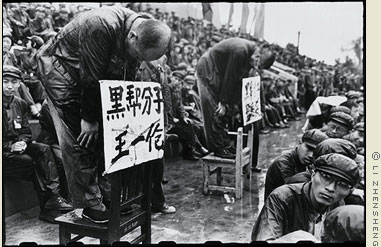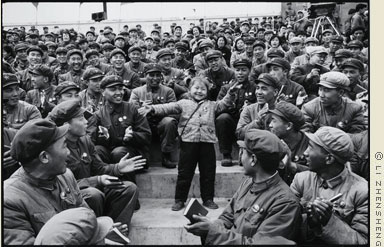|
Red-Color News Soldier is the literal translation of the Chinese
characters printed on the armband given to Li Zhensheng and his
rebel group in Beijing at the end of 1966, eight months after the
launch of the Great Proletarian Cultural Revolution. There are other,
more fluent translations, but none retains the musicality of the
character-words brought together.
For
a long time in the Western world, Mao Zedong and the Cultural Revolution
were perceived with amazement and fascination; only very rarely
were they viewed with horror. In the late 1960s and early 1970s,
rioting students around the world were inspired by the finger-pointing,
slogan-shouting style of the Red Guards, and Andy Warhol in New
York was producing his renowned silk-screen paintings of Chairman
Mao. Even today, all the chaos of that period can seem somewhat
romantic and idealistic in comparison with contemporary Chinese
society.

With
this in mind, it was necessary to produce a clearer and more truthful
image of the decade of turmoil that turned China upside-down. Li
Zhensheng was the one person who, through his unique photographic
legacy, could convey this truth on the printed page. A few guidelines
were established up-front: none of the photographs would be cropped;
the images would be presented in the most accurate chronological
order possible so as to best depict the historical process; precise
captions would accompany the images, with facts verified through
additional research and double-checked against the archives of The
Heilongjiang Daily, where the photographer worked for over eighteen
years.

Li
delivered to the offices of Contact Press Images in New York starting
in 1999 approximately thirty-thousand small brown paper envelopes
bound together with rubber bands in groups according to chronology,
location, type of film, or other criteria. Each envelope contained
a single negative inside a glassine pouch. Some of these had not
been removed since Li had first cut them from their original negative
strips and hidden them away thirty-five years earlier. On each envelope
Li had written detailed captions in delicate Chinese calligraphy.
Communes and counties, people's names, official titles, and specific
events were all carefully noted. Yet as Li's personal account written
by Jacques Menasche clearly demonstrates, his memory of the period
remains crisp and complete.
For
three years, from 2000 to 2003, a small group including Li, translator
Rong Jiang, Jacques, and I -- later to be joined by Li's daughter
Xiaobing -- met nearly every Sunday to collectively piece together
this history of a largely unknown era. In these exhausting and,
at times, animated sessions, we pored over a variety of archival
and scholarly documents, conducted interviews, reviewed images,
and even listened to Li sing revolutionary songs from the time.

During
the period of the Cultural Revolution the whole of China became
a theater in which the audience was increasingly part of the play˛from
the poorest peasant attending a "struggle session" to
the "class enemy" forced to bow at the waist in humiliation;
from the rarely seen leader waving from a Jeep to the denounced
and their denouncers; from the rebels to the counterrevolutionaries;
from the Red Guards to the old guard. With armbands and flags, banners
and big character posters, and Little Red Books turned into props,
the stage was dominated by the presence of an invisible diva, surrounded
by millions of extras, some shouting, some silenced.

But
thanks to the photographer, seemingly anonymous faces and places
take on names and identities. Li shows the surreal events to be
all too real. Through his lens, these people and occurrences from
so far away are made at once personal and universal, and all too
familiar. The Cultural Revolution unleashed the frustration and
anger of a new generation eager to change the world, but the force
was harnessed and used by those in power for a decidedly different
purpose: its own complete domination. In the late 1960s, student
riots erupted in other cities on other continents, but they never
resulted in the same premeditated violence initiated by those then
at the helm of the Chinese State.
We
will be forever grateful to Li for having risked so much to doggedly
preserve his images at a time when most of his colleagues agreed
to allow their politically "negative negatives" to be
destroyed. Li Zhensheng was a young man in search of himself --
as his numerous self-portraits clearly indicate -- who wished to
leave behind a trace of his own existence as well as his dreams
of individuality, elegance, and a better world. But History is the
issue here: the need to remember and revisit those strange and terrifying
events that shaped China's Great Proletarian Cultural Revolution.
2003
© Robert Pledge
|

